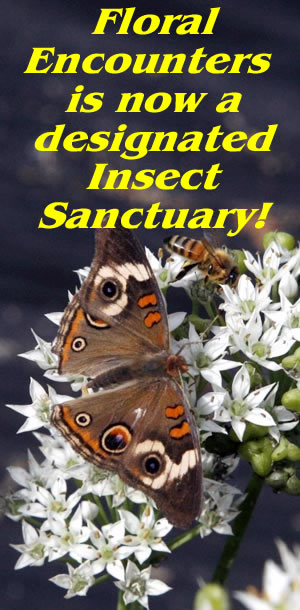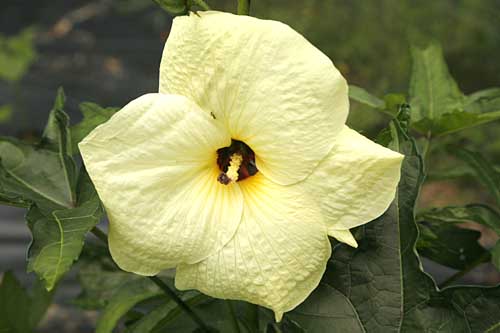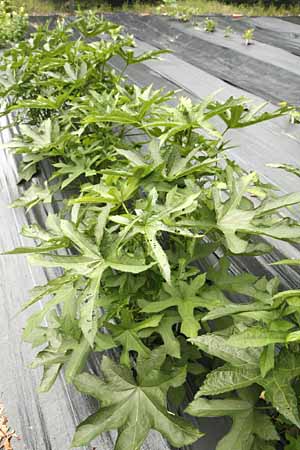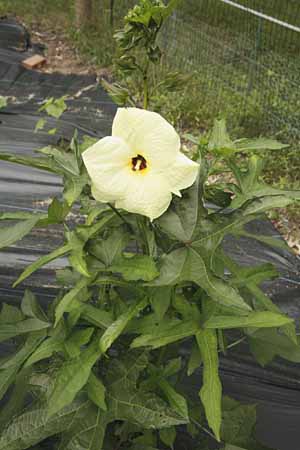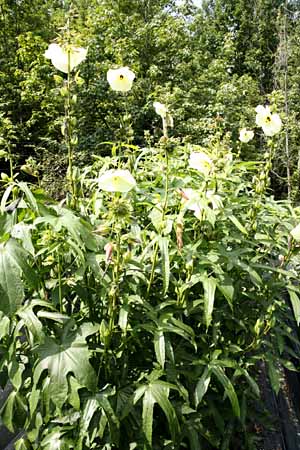Who said vegetable plants can't be ornamental. If you want drama in your garden then this is the plant for you. The huge lemon yellow flowers stand out and draw attention the themselves, even from the other end of our field these huge flowers can be seen and attract people to walk all the way over and look at them. However the importance of this plant is that it is one of the world's most nutritious leafy vegetables because of its high protein content. The leaves are tender and sweet and can be served raw or steamed. In Asia and northern Australia this plant is grow as a major crop since it can produce a large quantity of leaves for a small area.
Description.
Manihot is mainly a tropical shrub and is only hardy to zone 8/9 but will grow
in most zones as an annual. A member of the okra family it's a fast grower and
will reach six feet in height in one year and about 3-4 feet across. The leaves
can be up to 15 inches long but in the annual version they usually only reach
about 8-10 inches. They are broadly palmate and vary from barely lobed to cut
almost all the way to the leaf base. Once the plant has reached about four feet
in height it sends up large flower spikes which produce huge lemon colored flowers
up to 5 inches across with dark red or purple centers. Each flower only lasts
one day but they flowers are borne prolifically so there are new flowers every
day. From a spring planting flowers begin in early to mid summer and will continue
on until the frost kills the plants down. The flowers are also edible and can
be added to salads and other dishes. The flowers are followed by large ovate
seed pods which are produced in clusters at the end of the stems. These pods
can be cut and used as a very dramatic dried flower
Even if you don't want to eat it this plant is worth growing since its flowers are so large and beautiful it brings a tropical feel to any garden.
Growing.
Seeds are easy to grow, start inside in early spring in individual pots. They
germinate in about two weeks. Some sources suggest abrading the seed first and/or
soaking overnight but we have never found this necessary. Due to genetic diversification
some plant may develop with less tasty leaves so its prudent to plant several
and test the leaves as you go. Less tasty leafed plants can always be removed
if desired although flowers are still good in salads.
Location and Care.
Manihot needs full sun to grow well, it prefers a good soil with a high amount
of organic material (compost or mulch). It will grow in poorer soils but it
wont be as large or dramatic. If growing as a vegetable add compost, mulch and
then liquid feed during the year with higher nitrogen to create as many large
nutritional leaves as possible. It likes a fair amount of water, but will tolerate
a little drought.
Other uses.
Manihot also has medicinal properties. Research has shown it to be effective
for some kinds of depression especially post stroke depression. It is also effective
in reducing bone loss.
Other names
Abelmoschus Manihot, Aibika, Sunset Hibiscus, Aibika, Aelan kapis, Edible Hibiscus,
Slimy cabbage, Huang shu kui, Huangqiu Kui, Bele, Ran Bhendi, aibika, Creoles
and Pidgins,


